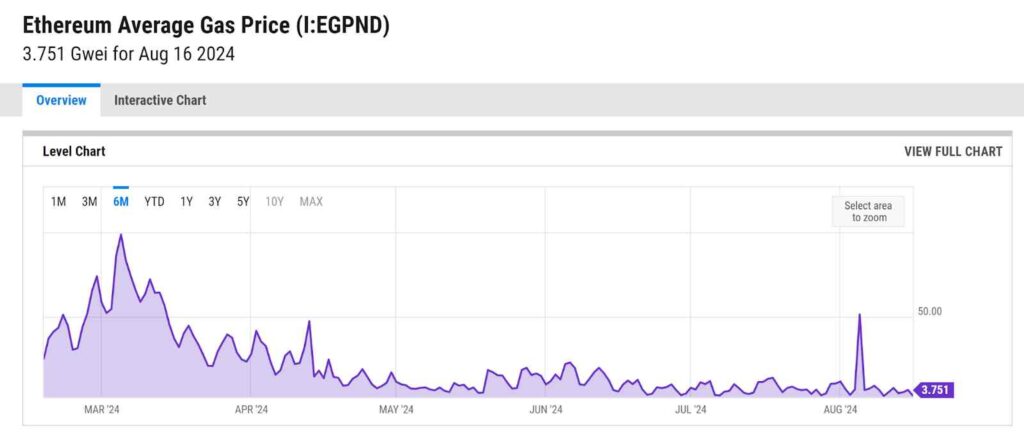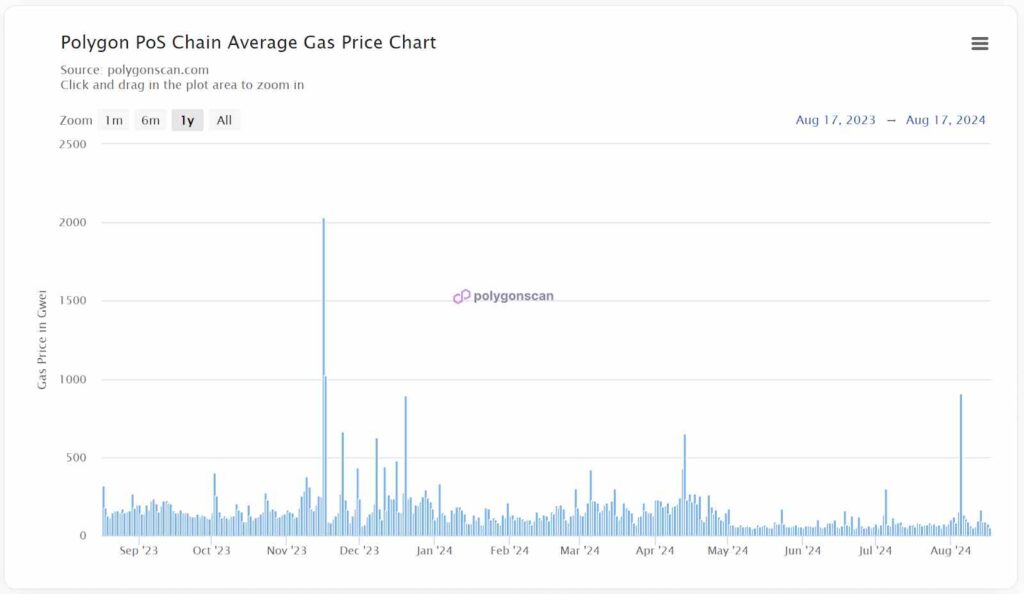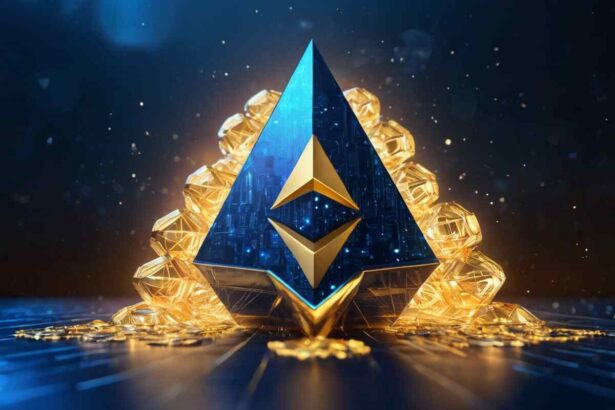Imagine turning a few thousand dollars into 1 million. Seems like a dream right. But crypto markets have done it in the past and can easily redo it in the future.
A report by Van Eck has opened up the possibility that could help you turn $14k into $1 million. The report highlights that Layer-2 markets could quickly scale up to $1 trillion market cap within the next six years to reach a $1 trillion valuation,
The predicted 7100% or 71x growth could be mainly possible because of a sudden but planned drop in Ethereum gas prices. The Dencun Upgrade, which scaled up Ethereum transactions, caused its TPS to increase from 15 to By mid-August 2024, this fee had fallen down to 1 Gwei from an average gas fee of 150-200 Gwei six months prior..

High Growth Potential in Layer-2 Markets
Ethereum saw a severe price decline in early August 2024 due to the outflows and the subsequent selling of ETH by Grayscale Ethereum Trust. The capital manager sold nearly $1 billion worth of ETH from 23 July 2024 to 5 August 2024, resulting in an excess of Ethereum in the markets. Unable to absorb the sell-offs, the markets soon crashed.
As a result, several Layer-2 coins were affected, and widespread selloff was seen in the markets. Ethereum dropped from $3000 levels to $2100 levels within a week.
This has created an opportunity to invest in the layer-2 markets while they are still in the accumulation zone. However, one needs to be careful in picking only the top ones with the highest market transaction share.
However, now that the L2 markets have fallen very low, we have a unique opportunity to accumulate the coins. DroomDroom.com collated multiple estimates from VanEck, independent experts, and analysts to present you with a massive opportunity to become a crypto millionaire.
To date, layer-2 chains have grown significantly. This growth can be seen in the graph below, where chief researcher Leon Widmann from OnchainHQ shows the L2 TVL growth.
This growth is expected to continue in the future due to the fall in Ethereum gas prices, which has suddenly made several blockchain applications cheaper to operate.
Ethereum’s gas prices reached a three-year low after the Dencun Upgrade was implemented in March 2024. Consequently, Layer-2 gas prices have become extremely affordable for implementing transaction-intensive blockchain applications like Metaverses, Real World Asset(RWA) tokenization, automated crypto trading, supply chain management, and several others.
Note: This estimate was primarily obtained from a report by VanEck, a crypto ETF issuer and one of the largest asset managers in the world. VanEck’s report estimates a $1 trillion market cap for Ethereum Layer-2s by the turn of the decade.
ETH Gas Prices Bring L2 Fees at a Multi-year Low
A critical problem in Ethereum was that its consensus mechanism resulted in a very slow network speed of 10-15 transactions per second. The low speed gave rise to an entire L2 market. However, even this market was expensive to use for blockchain applications with high transaction volumes.
In March 2024, Ethereum implemented the Dencun Upgrade, which used Proto-Dank Sharding to create a feature called “blobs.” These blobs acted like rollups and helped Ethereum reduce its transaction costs by over 99%.

As a result of the upgrade, the Ethereum gas price for average transaction speed reached a low of 1 Gwei by mid-Aug 2024.
Subsequent Fall in L2 Gas Fees
Since layer-2 chains use Ethereum to validate their rollups (a block of transactions), they must pay Ethereum a small fee called Blobscriptions. This fee to verify a block of L2 transactions costs the same as a single Ethereum transaction.
Hence, when the Dencun Upgrade caused the Ethereum gas fee to tank to 1 Gwei, this also caused a fall in L2 fees. For example, in Polygon, the average gas price was 650 Gwei on 13 April 2024, but it fell to 40 Gwei on 18 Aug 2024.

The markets have taken this fall very positively, and they expect it to boost blockchain adoption, especially in areas like Metaverses, Tokenization of equity derivatives, and a few others.
Sectors Benefiting from Low Layer-2 Gas Prices
The Ethereum Gas crash has revived hope for several sectors, such as Metaverses, Real-World Assets like tokenized stocks, on-chain trading bots, and much more.
Multiple sectors like RWA, metaverse worlds, automated trading and supply chain are highly dependent on Ethereum layer-2s for maintaining their affordability. Although other non-ETH blockchains provide similar services, however, the security and trust associated with the Ethereum ecosystem far outranks any other ETH competitor..
Metaverses
Several metaverses, including that of Disney, were shut down during the crypto winter because of their high operational costs. With reduced margins and high prices, most companies lost the possibility of making any profit.
Those projects that still exist to this date, like Sandbox and Attack Wagon, saw the value of their tokens crash by at least 95%. A revival in this sector could also indirectly lift the prices of these tokens.
However, since L2 gas prices have also fallen, these can easily help metaverses reduce costs while maintaining high on-chain security.
RWA – Tokenized Derivatives
Stock derivatives are among the most traded assets in the world. With a growing trend of tokenising real-world assets(RWA), we might soon see derivatives trading use blockchain technology to increase efficiency and transparency.
However, tokenising the derivatives markets would also need a high number of on-chain transactions. India’s National Stock Exchange alone accounted for 84 billion transactions in 2023.
Recording them on Ethereum or any other blockchain would surely congest it. Such a high volume would require a highly scalable layer-2 chain.
Mere tokenisation of a single country, India, would help layer-2 markets earn billions of dollars in fees and quickly reach a $1 trillion valuation.
Utility Transactions
The low layer-2 fees also promote adopting blockchain technology for utility transactions. Daily utilities such as paying for public transport, eating out, and affordable healthcare would rapidly adopt blockchain technology, especially layer-2s.
Another reason for an increased preference for Layer-2 blockchains could be their advantage in blockchain interoperability. Since all Layer-2 chains are based on Ethereum architecture, cross-chain transfer of assets among L2 chains and Ethereum will require less development.
Conclusion
Layer-2 chains provide many additional benefits, such as lower gas fees, high scalability, and cross-chain capabilities, despite maintaining high on-chain security.
These factors will definitely contribute towards a better and growth-intensive future, validating VanEck’s assumption of a $1 trillion Layer-2 market by 2030.



















